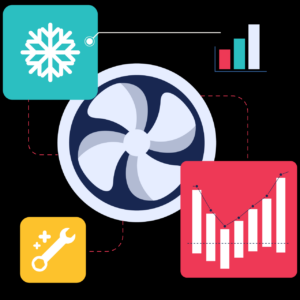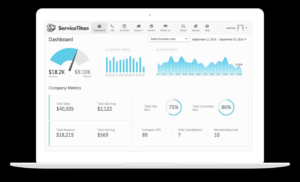In the competitive world of HVAC, businesses are constantly seeking ways to optimize operations, enhance efficiency, and provide exceptional customer service. HVAC business software emerges as a game-changer, offering a comprehensive suite of tools to streamline processes, automate tasks, and gain valuable insights.
This software empowers HVAC contractors to elevate their business to new heights, ensuring seamless operations, satisfied customers, and a thriving bottom line.
Delving into the realm of HVAC business software, we will explore its essential functionalities, navigate the various types available, and provide a roadmap for successful implementation. Furthermore, we will uncover the data management and analytics capabilities that empower businesses to make informed decisions, and delve into the customer relationship management (CRM) features that foster lasting relationships with clients.
Embark on this journey with us, and discover how HVAC business software can transform your operations and propel your business towards success.
Contents
- 1 Software Functionality and Capabilities
- 2 Types of HVAC Business Software
- 3 Implementation and Integration
- 4 Data Management and Analytics
- 5 Customer Relationship Management (CRM)
- 5.1 Tracking Customer Interactions Logs all customer interactions, including phone calls, emails, and in-person meetings. Provides a complete history of customer interactions, making it easy to track the progress of sales opportunities. Automates follow-up tasks, ensuring that no leads fall through the cracks. Managing Customer Data
- 5.2 Improving Customer Satisfaction
- 6 Closing Notes
Software Functionality and Capabilities
HVAC business software is designed to streamline and automate various aspects of HVAC operations, providing businesses with a comprehensive solution for managing their daily tasks and improving efficiency.
The software typically includes features such as:
- Customer management:Track customer information, appointments, and service history.
- Scheduling:Create and manage schedules for technicians, appointments, and work orders.
- Dispatching:Assign technicians to jobs, track their progress, and provide real-time updates.
- Invoicing and billing:Generate invoices, track payments, and manage accounts receivable.
- Inventory management:Track inventory levels, manage parts, and reorder supplies as needed.
- Reporting and analytics:Generate reports on key performance indicators, such as technician productivity, customer satisfaction, and revenue.
Benefits of Using HVAC Business Software
Using HVAC business software offers several benefits, including:
- Increased efficiency:Automation and streamlining of tasks saves time and reduces manual labor.
- Improved customer service:Faster response times, better communication, and accurate record-keeping enhance customer satisfaction.
- Enhanced profitability:Reduced costs, increased technician productivity, and improved billing accuracy lead to increased profits.
- Data-driven decision-making:Reporting and analytics provide insights into business performance, enabling informed decisions.
- Improved compliance:Software can help businesses stay compliant with industry regulations and standards.
Types of HVAC Business Software
HVAC business software comes in various types, each tailored to specific business needs and operations. Understanding the different types and their features is crucial for selecting the most suitable software for your company.
On-Premise Software
On-premise software is installed locally on your company’s servers and is managed internally. It provides complete control over data and customization options but requires significant upfront investment in hardware, infrastructure, and IT support.
Cloud-Based Software
Cloud-based software is hosted on remote servers and accessed through an internet connection. It offers flexibility, scalability, and lower upfront costs but may have limitations in customization and data security.
Factors to Consider When Choosing Software
When selecting HVAC business software, consider the following factors:
- Business size and complexity
- Specific industry requirements
- Budget and resource constraints
- Desired features and functionalities
- Data security and privacy concerns
Implementation and Integration

Implementing and integrating HVAC business software can streamline operations and enhance efficiency. Here’s a comprehensive guide to assist you through the process.
Before implementing the software, it’s crucial to plan thoroughly. This involves defining clear goals, identifying key stakeholders, and establishing a realistic timeline. Engage with your team to gather input and ensure buy-in from all levels of the organization.
Step-by-Step Implementation Guide
- Gather Requirements:Define the specific needs and functionalities required from the software. Conduct thorough research and consult with industry experts to identify the best fit for your business.
- Select Software:Evaluate different software options based on your requirements, budget, and scalability needs. Conduct demos, read reviews, and seek references to make an informed decision.
- Install and Configure:Follow the software vendor’s instructions to install and configure the software on your systems. Ensure proper network connectivity and access for authorized users.
- Data Migration:Transfer existing data from your current systems into the new software. This may involve manual entry, automated migration tools, or professional assistance.
- Testing and Validation:Conduct thorough testing to ensure the software is functioning as expected. Validate its accuracy, reliability, and user-friendliness before going live.
- Go Live:Launch the software and make it accessible to users. Monitor its performance closely and provide ongoing support to ensure a smooth transition.
Integration Challenges and Best Practices
Integrating HVAC business software with existing systems can present challenges. Here are some best practices to overcome them:
- Data Compatibility:Ensure that the software is compatible with your existing data formats and systems. Consider using data conversion tools or middleware to bridge any gaps.
- API Integration:Utilize application programming interfaces (APIs) to connect the software with other systems, such as CRM or ERP. This allows for seamless data exchange and automated processes.
- Cloud-Based Solutions:Cloud-based HVAC business software can simplify integration by eliminating the need for on-premise infrastructure. It offers flexibility, scalability, and remote access.
- Phased Approach:Implement the software in phases to minimize disruption and allow for gradual adaptation. This approach provides time for staff training and feedback collection.
Staff Training
Effective staff training is essential for successful software implementation. Here are some key considerations:
- Identify Training Needs:Assess the specific training needs of each user group and develop tailored training programs.
- Utilize Diverse Training Methods:Employ a combination of classroom training, hands-on workshops, and online resources to cater to different learning styles.
- Provide Ongoing Support:Offer ongoing support and resources to users after the initial training. This includes access to documentation, online forums, and technical assistance.
- Encourage User Feedback:Collect feedback from users throughout the training process to identify areas for improvement and enhance the overall experience.
Data Management and Analytics
HVAC business software offers robust data management capabilities, enabling businesses to collect, organize, and analyze data related to their operations. This data can include equipment performance, energy consumption, maintenance schedules, and customer information.
By centralizing data in a single system, the software provides a comprehensive view of business operations, allowing managers to track key performance indicators (KPIs) and identify areas for improvement.
Reports and Dashboards
HVAC business software typically includes a suite of reporting and dashboard tools that allow businesses to visualize and analyze data. These tools enable users to:
- Generate custom reports on specific aspects of their business, such as equipment efficiency, energy consumption, or maintenance costs.
- Create dashboards that display real-time data on key metrics, such as equipment status, energy usage, and customer satisfaction.
- Set up alerts and notifications to be informed of critical events, such as equipment failures or customer complaints.
Customer Relationship Management (CRM)
HVAC business software often includes robust CRM capabilities that help businesses manage customer interactions and track leads throughout the sales pipeline. These tools provide a centralized platform for storing customer data, managing communication, and tracking customer interactions.

